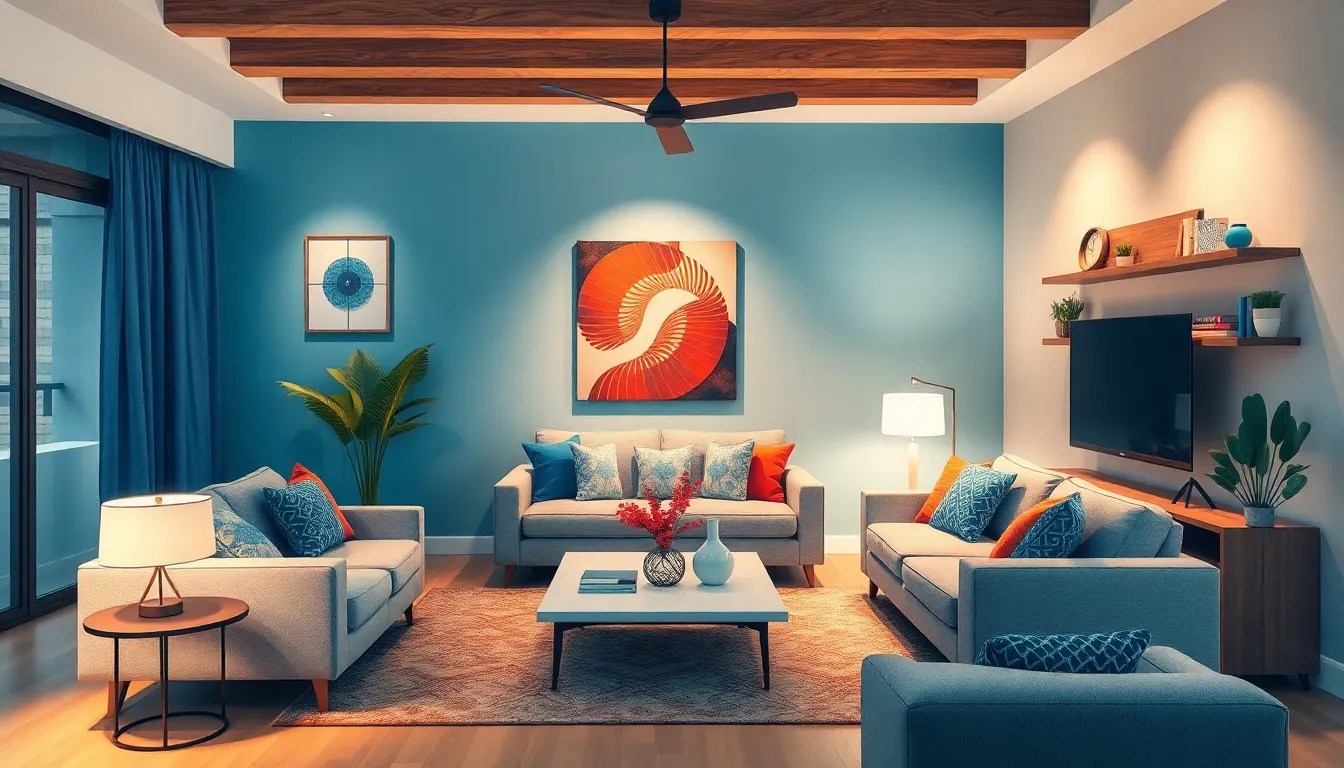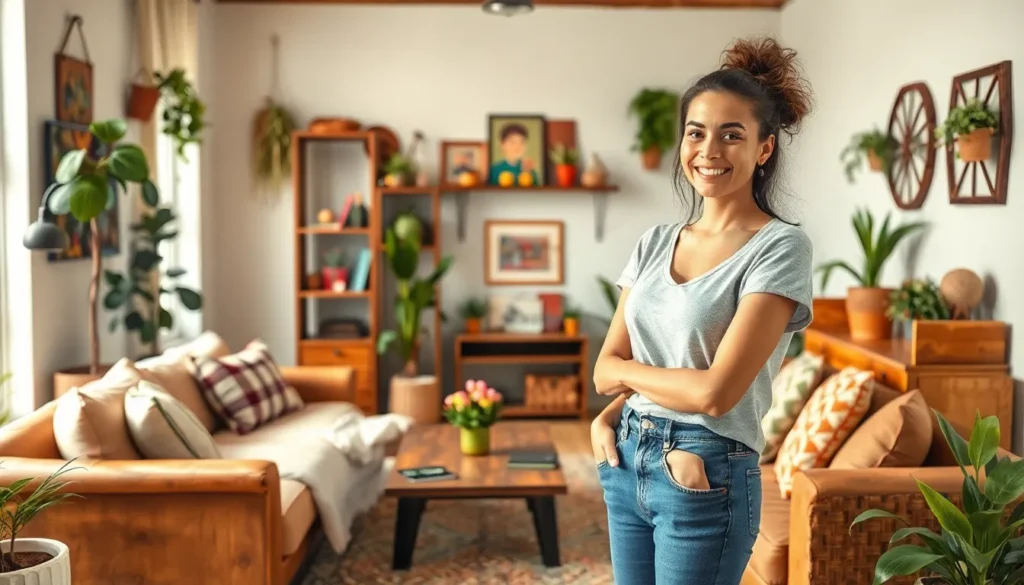Table of Contents
ToggleWhen it comes to interior design, it’s not just about making a space look pretty—it’s about creating an experience that reflects personality and style. Imagine walking into a room that feels like a warm hug or a refreshing breeze. Sounds dreamy, right? Interior design concepts are the secret sauce to transforming ordinary spaces into extraordinary havens.
From minimalist chic to bohemian bliss, there’s a concept for every taste. Whether you’re a fan of bold colors or prefer a more subdued palette, understanding these design principles can turn your home into a masterpiece. So grab your paintbrush and let’s dive into the world of interior design, where creativity knows no bounds and every corner can tell a story.
Overview of Interior Design Concepts
Interior design concepts form the foundation of creating functional and visually appealing spaces. A wide range of styles exists, each embodying unique characteristics.
Minimalism emphasizes simplicity through clean lines and uncluttered spaces. This design approach fosters tranquility by stripping away distractions. On the contrary, bohemian design incorporates vibrant colors and eclectic patterns, encouraging personal expression.
Industrial style highlights raw materials like exposed brick and metal surfaces. This concept connects to urban aesthetics by showcasing the beauty of unfinished elements. Meanwhile, contemporary design focuses on current trends, merging function and style seamlessly.
Traditional designs reflect timeless elegance through classic furniture and rich textures. This style often includes ornate details, creating a sense of history and sophistication. In contrast, mid-century modern showcases simplicity and organic shapes, prioritizing functionality alongside aesthetics.
Scandinavian design promotes a cozy atmosphere with light colors and natural materials. This concept often integrates sustainability, valuing eco-friendly practices. Rustic design embraces a warm, inviting ambiance through natural elements like wood and stone.
Each design concept incorporates lighting, color schemes, and furniture layout as essential components. Understanding these elements aids in crafting cohesive spaces. Choosing the right concept enhances functionality and conveys one’s personality, shaping a unique living environment.
Exploring various interior design concepts offers inspiration for transforming homes. Different styles cater to individual preferences, making it easy to find the perfect match. Engaging with these principles stimulates creativity and invites storytelling within every room.
Key Elements of Interior Design

Interior design hinges on several key elements that contribute to appealing and functional spaces. Each element plays a pivotal role in shaping the overall design aesthetic and atmosphere.
Color Theory
Color theory encompasses the emotional impact of colors in space. Colors can create moods; for example, blue can evoke calmness while red may stimulate energy. Designers consider color wheels to combine hues effectively and create harmony. Incorporating complementary colors can enhance the visual interest of a room. Also, neutral shades provide a versatile backdrop that allows for pops of color through accessories and artwork. Ultimately, selecting a cohesive color palette is essential for transforming any space.
Furniture Layout
Furniture layout defines the flow and functionality of a room. Arranging furniture strategically promotes conversation and comfort while maximizing space. Functional zones can be created by grouping furniture logically around activities, such as seating for socializing and tables for eating. Clear pathways between pieces enhance accessibility and ease of movement. Furthermore, varying heights of furniture adds visual excitement and dimension to the space. Prioritizing an efficient layout encourages an inviting and usable environment.
Lighting Design
Lighting design is crucial in setting the mood and highlighting features within a room. Various types of lighting, including ambient, task, and accent, contribute to a well-lit space. Natural light should be utilized as much as possible to create warmth and a sense of openness. Task lighting focuses on specific areas to improve functionality, such as reading nooks or workspaces. Incorporating dimmers allows for adaptability in lighting levels, catering to different activities and times of day. Thoughtful lighting choices amplify both the utility and aesthetics of interiors.
Popular Interior Design Styles
Many compelling interior design styles cater to diverse preferences. Each style incorporates unique elements that contribute to the overall ambiance of a space.
Modern Minimalism
Modern minimalism emphasizes simplicity and function, focusing on clean lines. This design style reduces clutter, instead highlighting essential elements. Neutral color palettes, including whites and grays, create calm environments. Furniture often features sleek designs, maintaining a cohesive aesthetic. Natural light plays a crucial role, enhancing openness within a room. Accessories remain minimal, allowing for intentional decoration that doesn’t overwhelm. Overall, modern minimalism promotes tranquility and spaciousness.
Rustic Charm
Rustic charm embraces warmth and a connection to nature. This style incorporates natural materials like wood, stone, and metals. Earthy color palettes, featuring browns, greens, and muted hues, enhance the inviting atmosphere. Furniture often reflects a handcrafted, lived-in quality, adding character to spaces. Textiles like wool and linen contribute warmth and texture. Elements such as exposed beams or vintage accents ground the design in the rural aesthetic. Rustic charm fosters cozy, relaxing environments that invite people to gather.
Industrial Edge
Industrial edge design showcases raw materials and urban influences. Exposed brick walls, concrete floors, and metal fixtures create an edgy atmosphere. Furniture often combines wood and metal, contributing to the contemporary aesthetic. Dark color schemes, enhanced by pops of color, evoke a moody yet sophisticated vibe. Large windows maximize natural light while emphasizing industrial features. Minimal decorations highlight essential elements without overwhelming the space. This style attracts those who appreciate the beauty of functional, unrefined materials.
Incorporating Personal Touches
Creating a space that reflects individual personality enhances the overall atmosphere of a home. Personal touches add warmth and uniqueness, making a residence feel inviting and lived-in.
Art and Decor
Art serves as a powerful medium for personal expression in interior design. It invites conversation and sets the tone for a room. Selecting pieces that resonate with individual tastes and experiences creates a meaningful connection. Wall art, sculptures, and decorative items can showcase creative style while contributing to the room’s character. Mixing different art forms, such as paintings and prints alongside photographs, provides a layered aesthetic that showcases personality. Furthermore, incorporating local artists’ works celebrates community and adds authenticity to the space.
Personal Collections
Showcasing personal collections adds character and tells stories through curated items. Whether it’s vintage books, travel souvenirs, or unique finds, collections prompt nostalgia. Each piece reveals a part of the collector’s journey, creating an engaging narrative. Displaying these items strategically, such as in open shelves or glass cabinets, allows for visibility while maintaining organization. Using thoughtful arrangements can also create visually striking focal points. Personal collections not only enhance decor but also invite conversations and connections among family and guests.
Interior design is a powerful tool that shapes not only the aesthetic of a space but also the experiences within it. By understanding various design concepts and styles, individuals can infuse their homes with personality and warmth. Each element from color to furniture layout plays a crucial role in creating inviting environments that reflect personal stories and preferences.
Encouraging creativity and self-expression, interior design allows for unique storytelling in every corner. Whether opting for the simplicity of minimalism or the vibrancy of bohemian decor, the possibilities are endless. Embracing these principles can lead to transformative spaces that resonate with comfort and style.




